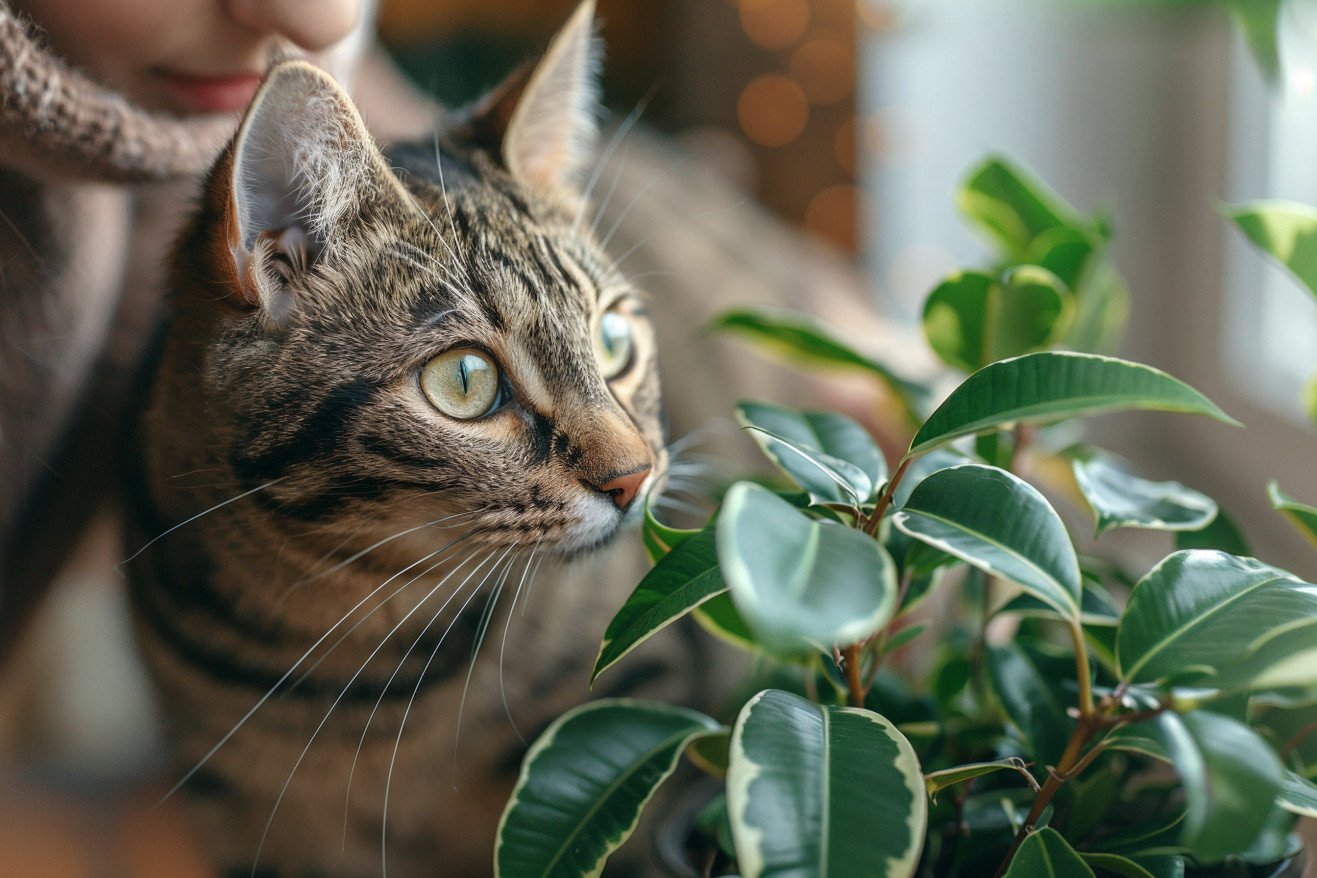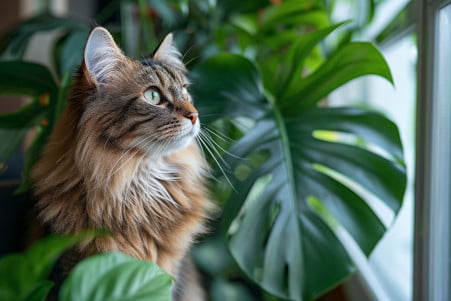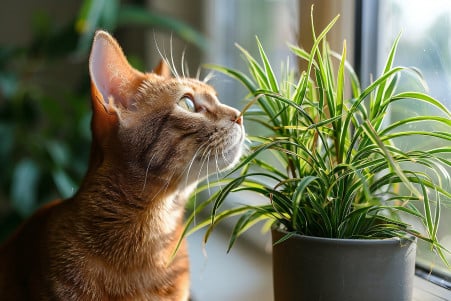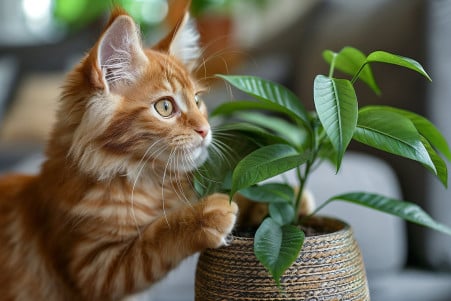Can Cats Eat Rubber Plants? What You Should Know
26 April 2024 • Updated 25 April 2024

If you’re a cat parent who’s worried about whether or not rubber plants are safe to keep in your home, it’s important to know that rubber plants (Ficus elastica) are mildly toxic to cats. The sap and leaves of the rubber plant can cause oral irritation, excessive drooling, vomiting, and difficulty swallowing in cats. Although these symptoms are not usually severe, it’s still a good idea to keep rubber plants in a place where your cat can’t get to them.
Although this information may sound alarming, there are things you can do to make sure your cat stays safe. This article will explore the findings of veterinary toxicologists, feline behaviorists, and horticulturalists to help you better understand the details of rubber plant toxicity in cats. Their input will help you learn how to handle plants responsibly, cat-proof your home, and spot the signs of toxicity. Armed with this information, you can decide whether or not you want to bring rubber plants into your cat-friendly space.
Are rubber plants toxic to cats?
How Rubber Plants Are Toxic to Cats
The rubber plant's toxicity to cats is largely due to the presence of chlorogenic acid, as well as other irritating compounds in the plant's milky sap. According to research cited by Greg.app, when this sap is consumed or even just touches a cat's skin, it can cause gastrointestinal upset, depression, and ataxia (i.e., loss of coordination).
The immediate signs of rubber plant poisoning in cats include vomiting, diarrhea, drooling, depression, and ataxia, as per the Pet Poison Helpline. Behavioral changes and litter box problems are among the delayed signs. Although symptoms are generally not fatal, it's important to seek veterinary treatment immediately if you suspect your cat has been exposed to rubber plant to prevent long-term complications.
It's worth noting that different rubber plant species, including variegated and burgundy rubber plants, have different levels of toxicity. The ASPCA's description of the burgundy rubber tree explains that it contains latex, which is the main irritant responsible for the oral and gastrointestinal signs of poisoning in cats.
In addition to ingestion, cats can be poisoned by rubber plants through skin contact and inhalation of the sap. Cats don't produce the enzymes necessary to efficiently digest plant cell walls, which means that eating any plant can be dangerous for them, according to Greg.app's research.
Although rubber plants are clearly toxic to cats, it's important to debunk the myth that a single leaf or small amount of the plant is deadly. The severity of a cat's reaction depends on the amount of the plant they've consumed and their individual sensitivity. With quick intervention and veterinary treatment, most cases of rubber plant poisoning can be treated successfully.
How to Keep Cats Away From Rubber Plants
As shown in a study by City Blooming, understanding cats' natural behaviors is the first step to addressing their plant-eating habits. Textures, smells, and tastes all play a role in what makes a plant appealing to a cat, so physical barriers and deterrents can be used to keep them away.
There are several ways that cat owners can keep their cats from eating rubber plants. City Blooming recommends using physical barriers such as chicken wire, mesh, or plant cages to protect the plants. Cat repellent sprays that contain natural ingredients and have strong odors can also be used to deter cats from coming near the plants.
Another way to keep cats from eating rubber plants is to use citrus peels or sprinkle spices like cayenne pepper and cinnamon around the plants, according to City Blooming. The way that the plants are arranged can also limit cats' ability to access them.
Lively Root recommends creating pathways and using deterrents such as double-sided tape and prickly mulch to keep cats away from the plants. However, it's important to note that ongoing supervision and intervention will be necessary when rubber plants are brought into a home with cats.
By using these methods, cat owners can help ensure that their cats and rubber plants can coexist in the same space.
Emergency Response: What to Do If Your Cat Ingests a Rubber Plant
If your cat eats any part of a rubber plant, it’s important to act quickly. Per Greg.app, the first thing you should do is call a licensed veterinarian immediately. When you do, you should be prepared to tell them what your cat ate, how much they ate, and what symptoms they’re showing.
The WagWalking article also suggests rinsing your cat’s mouth with distilled water to get rid of any sap that could be causing irritation. After that, the vet may induce vomiting or give your cat activated charcoal to help absorb and remove the toxins from their system.
It’s also important to watch your cat for signs of vomiting, diarrhea, lethargy, and lack of coordination. Per Greg.app, while the symptoms of rubber plant poisoning are usually not serious, taking your cat to the vet quickly can help keep a minor issue from becoming a major one. Waiting to seek treatment can lead to more serious symptoms.
However, if you act fast and follow the advice of a professional, you can help make sure your cat is safe and healthy after eating a rubber plant. This knowledge can help you feel more confident in your ability to care for your pet.
Cat-Safe Houseplant Alternatives: Non-Toxic Options to Consider
As shown in a study by The Spruce, many of the most popular houseplants are non-toxic to cats. Boston ferns (Nephrolepis), African violets (Saintpaulia), and baby's tears (Soleirolia soleirolii) are just a few of the many cat-safe options. These plants can help you bring the outdoors in without worrying about your cat's safety.
The BBC Gardeners World Magazine lists other non-toxic plants including the pineapple plant (Ananas comosus), cast iron plant (Aspidistra elatior), and Chinese money plant (Pilea peperomioides). Some of these plants even have the added benefit of purifying the air or being easy to care for, which may make them especially attractive to cat owners.
It's important to always check plant toxicity lists before bringing new plants into your home, as mentioned by Bond Vet. The ASPCA's database is a great place to look for safe plants. When you do bring non-toxic plants into your home, Good Housekeeping recommends keeping them out of your cat's reach and using deterrents to help keep your cat away. You should also continue to keep an eye on your cat's interactions with non-toxic plants to ensure that everyone continues to get along.
How to Create a Cat-Safe Indoor Garden: Tips and Ideas
Introducing non-toxic indoor plants into a cat-friendly home can be beneficial in many ways. As reported by Architectural Digest, plants like the Chinese Money Plant, various Hoyas, and the Ponytail Palm can not only make a room more attractive and interesting, but they can also help clean the air. Meanwhile, the PureWow article explains that with the right precautions, cat parents can enjoy the soothing presence of plants without worrying about their pet's well-being.
When choosing and arranging safe plants, Trupanion suggests looking for compact, trailing plants that can be displayed on shelves or in hanging planters. This will help keep the plants out of a cat's reach while still allowing you to enjoy them. Meanwhile, the Preventive Vet recommends mixing and matching plants like Peperomia Obtusifolia, Maranta Leuconeura, and Chlorophytum Comosum to create an interesting and attractive indoor garden.
To help ensure that cats and plants coexist peacefully, Architectural Digest suggests setting up "cat-friendly" areas with safe, edible plants like cat grass or catnip to give cats a place to indulge their plant-eating instincts. Meanwhile, keeping an indoor garden healthy while keeping cats in mind will require regular watering, pruning, and monitoring for signs of trouble.
It's also important to stay flexible and keep an eye on the situation to make sure that cats and plants continue to get along. As mentioned by PureWow, even non-toxic plants can cause digestive upset if a cat eats enough of them. Regularly checking in on your indoor garden and making changes as needed will help ensure that both your cat and your plants stay safe and healthy.
Conclusion: How to Keep Cats and Plants Safe and Happy
Although rubber plants can be dangerous to cats, there are many non-toxic houseplant options that will allow you to have a beautiful indoor garden without putting your cat at risk. By learning about the specific toxins in rubber plants and the symptoms they can cause, cat owners can work to prevent their cats from being exposed.
Physical barriers, deterrents, and strategic placement of plants out of your cat’s reach can all help you create a cat-safe indoor garden. It’s also important to be prepared for emergencies in case your cat does eat part of a rubber plant.
In the end, you can keep your cat safe and still have non-toxic plants in your home. With the right information and precautions, you can enjoy the benefits of indoor greenery without worrying about your cat, and both you and your feline friend can live happily and healthily in a plant-filled home.


